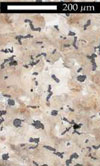Compacted Graphite Iron, or....not?
 In the July 2010 issue of RET-Monitor, keyword: heads-blocks, I gave some insight into fracture splitting of the main bearing cap. The advantages of a fractured split line were discussed, including the design freedom that can be achieved using fracture splitting.
In the July 2010 issue of RET-Monitor, keyword: heads-blocks, I gave some insight into fracture splitting of the main bearing cap. The advantages of a fractured split line were discussed, including the design freedom that can be achieved using fracture splitting.
What I did not mention though - and this is where this article connects to the previous one - is the fact that fracture splitting cannot be done with every type of cast iron. Based on the process-specific requirements, fracture splitting is possible when using Compacted Graphite Iron (CGI) material. So would there be more to gain using this material, and what are the limitations?
CGI is a cast material that sits between ductile and gray cast iron, and which has better thermal conductivity and fatigue properties than gray cast iron. In particular the higher temperature fatigue limit of CGI, being higher than aluminium, makes it the 'perfect' material for blocks and heads.
For highly loaded engine blocks, the main advantage is the strength of the material, making it well suited for optimising block geometry, given the focus on reducing wall thicknesses. Some studies say a mass decrease of up to 20% should be achievable. Whether this number is correct or not is not the issue here, but it shows the potential of the material.
To achieve the maximum gain in weight, the design engineer will always try to reduce the wall thickness as much as possible, until either strength or process stability prevents him from going any further. Based on the mechanical properties of CGI, which has a tensile strength typically in the region of 450N/mm2, the wall thickness is not normally limited by the material but by the casting process.
Currently, nominal wall thicknesses can be cast at about 3mm for a typical crankcase size, while still allowing some tolerances on the pattern side and to provide enough 'path' for the melted iron to flow through, without the risk of cold shut. In non-structural parts of the crankcase and other low-stress areas, such as engine skirts, it's desirable to reduce the wall thickness to less than 3mm. Compared with aluminium, this would lead to a competitive crankcase weight. Unfortunately though the casting process prevents the engineer from achieving this.
Would it not be ideal then if CGI could be used only in the areas where maximum strength is required, and where the casting process can achieve the required geometries - as in bulkheads, the cylinder liner and top deck? All other areas could be made in a more suitable material, such as magnesium or aluminium, perhaps even engineering plastic. There are some examples of these hybrid designs, such as BMW with its aluminium-magnesium hybrid block casting, and Volkswagen with the hybrid cast-iron structure integrated into an aluminium crankcase casting.
A known area of concern with these hybrid castings, however, is the connection between the cast iron and aluminium materials internally in the casting, where contact corrosion could occur locally. But let's assume that in the end this should be solvable, especially for non-long term racing blocks, making it a very mass-optimum concept.
Combining such hybrid engine block technology with the fracture-split main bearing cap and its ability to reduce overall length of the engine (see former article) would have the potential to achieve maximum weight reduction. Given the developments and trends towards an increase in diesel race series, where peak firing pressure is the key to high performance, these series would benefit the most from the hybrid CGI application. The current regulatory discussions around downsizing and the use of turbocharging could also prompt a move towards these kind of hybrid crankcase designs, using CGI as skeleton within the crankcase.
But the question of course will be if developing such technologies is affordable in a time where costs need to be maintained at acceptable levels.
Fig. 1 - Structure of Compacted Graphite Iron
Written by Dieter van der Put